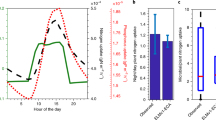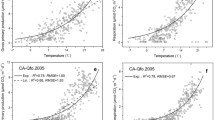Abstract
Ecosystem-, biome-, and global-level oxidative ratio (OR) estimates are used to understand ecosystem gas exchange processes, and assess the sizes of the terrestrial biosphere and ocean carbon sinks, and the mechanisms controlling them. We have developed analytical methods to measure the OR of terrestrial carbon stocks from biomass chemistry that give accurate and precise estimates of ecosystem atmosphere-biosphere gas flux OR. Here we apply these techniques to agricultural ecosystems to address two uncertainties: (1) whether changing crop species distribution can change ecosystem OR, and (2) whether nutrient status can change ecosystem OR. Analyzing the top three crops in the U.S. (soybean, corn, wheat), we showed differences between the OR of net primary production (ORab) of legumes (1.109 ± 0.003) versus grass crops (corn: 1.028 ± 0.001; wheat: 1.033 ± 0.001). Our preliminary estimate of the average U.S. agriculture ORab is 1.058 in 2010, and extrapolations indicate that the U.S. agricultural ORab has increased from 1.040 in 1930, likely due to shifts in agricultural land use (e.g. oat acreage decreases while soybean acreage increases over time). We also observed that increasing nitrogen fertilization rate led to only a small increase in ORab. Taken together, our results indicate that it is possible for biome-level ORab to vary over time and space. The largest driver of ORab variation in this study was variation in crop distribution, which changed ORab by an order of magnitude more than variations in nitrogen fertilizer application.



Similar content being viewed by others
References
Bakker DCE (2004) Storage of carbon dioxide by greening of oceans? In: Field CB, Raupach MR (eds) The global carbon cycle: integrating humans, climate, and the natural world, vol 62., Island Press Washington, D.C., pp 453–469
Baldock JA, Masiello CA, Gélinas Y, Hedges JI (2004) Cycling and composition of organic matter in terrestrial and marine ecosystems. Mar Chem 92(1–4):39–64. doi:10.1016/j.marchem.2004.06.016
Bender M, Battle M, Keeling R (1998) The O2 balance of the atmosphere: a tool for studying the fate of fossil-fuel CO2. Ann Rev Energy Environ 23:207–223. doi:10.1146/annurev.energy.23.1.207
Chapin FS, Woodwell GM, Randerson JT, Rastetter EB, Lovett GM, Baldocchi DD, Clark DA, Harmon ME, Schimel DS, Valentini R, Wirth C, Aber JD, Cole JJ, Goulden ML, Harden JW, Heimann M, Howarth RW, Matson PA, McGuire AD, Melillo JM, Mooney HA, Neff JC, Houghton RA, Pace ML, Ryan MG, Running SW, Sala OE, Schlesinger WH, Schulze E-D (2006) Reconciling carbon-cycle concepts, terminology, and methods. Ecosystems 9(7):1041–1050. doi:10.1007/s10021-005-0105-7
Ciais P, Manning AC, Reichstein M, Zaehle S, Bopp L (2007) Nitrification amplifies the decreasing trends of atmospheric oxygen and implies a larger land carbon uptake. Glob Biogeochem Cycles 21:GB2030. doi:10.1029/2006GB002799
Cousins AB, Bloom AJ (2004) Oxygen consumption during leaf nitrate assimilation in a C3 and C4 Plant: the role of mitochondrial respiration. Plant, Cell Environ 27:1537–1545. doi:10.1111/j.1365-3040.2004.01257.x
Crum JR, Collins HP (1995) KBS-LTER site soil description. Kellogg Biological Station Long-Term Ecological Research, Michigan State University. http://lter.kbs.msu.edu/research/site-description-and-maps/soil-description/. Accessed 1 August 2014
Dilly O (2001) Microbial respiratory quotient during basal metabolism and after glucose amendment in soils and litter. Soil Biol Biochem 33(1):117–127
Gallagher ME, Hockaday WC, Masiello CA, Snapp S, McSwiney CP, Baldock JA (2011) Biochemical disincentives to fertilizing cellulosic ethanol crops. Environ Sci Technol 45:2013–2020. doi:10.1021/es103252s
Galloway JN, Townsend AR, Erisman JW, Bekunda M, Cai Z, Freney JR, Martinelli LA, Seitzinger SP, Sutton MA (2008) Transformation of the nitrogen cycle: recent trends, questions, and potential solutions. Science 320:889–892. doi:10.1126/science.1136674
Grandy AS, Robertson GP (2007) Land-use intensity effects on soil organic carbon accumulation rates and mechanisms. Ecosystems 10:58–73. doi:10.1007/s10021-006-9010-y
Hockaday WC, Masiello CA, Randerson JT, Smernik RJ, Baldock JA, Chadwick OA, Harden JW (2009) Measurement of soil carbon oxidation state and oxidative ratio by 13C nuclear magnetic resonance. J Geophys Res 114(G2):G02014. doi:10.1029/2008JG000803
Hockaday WC, Gallagher ME, Masiello CA, Baldock JA, Iversen CM, Norby RJ Elevated atmospheric carbon dioxide concentrations cause an increase in soil carbon oxidation state and ecosystem oxidative ratio. J Geophys Res (Manuscript In Preparation)
Ishidoya S, Murayama S, Takamura C, Kondo H, Saigusa N, Goto D, Morimoto S, Aoki N, Aoki S, Nakazawa T (2013) O2:CO2 exchange ratios observed in a cool temperate deciduous forest ecosystem of central Japan. Tellus B 65:21120. doi:10.3402/tellusb.v65i0.21120
Keeling RF, Shertz SR (1992) Seasonal and interannual variations in atmospheric oxygen and implications for the global carbon cycle. Nature 358:723–727. doi:10.1038/358723a0
Keeling RF, Piper SC, Heimann M (1996) Global and hemispheric CO2 sinks deduced from changes in atmospheric O2 concentration. Nature 381:218–221. doi:10.1038/381218a0
Le Quere C, Raupach MR, Canadell JG, Marland G, Bopp L, Ciais P, Conway TJ, Doney SC, Feely RA, Foster P, Friedlingstein P, Gurney K, Houghton RA, House JI, Huntingford C, Levy PE, Lomas MR, Majkut J, Metzl N, Ometto JP, Peters GP, Prentice IC, Randerson JT, Running SW, Sarmiento JL, Schuster U, Sitch S, Takahashi T, Viovy N, van der Werf GR, Woodward FI (2009) Trends in the sources and sinks of carbon dioxide. Nat Geosci 2(12):831–836. doi:10.1038/ngeo689
Manning AC, Keeling RF (2006) Global oceanic and land biotic carbon sinks from the scripps atmospheric oxygen flask sampling network. Tellus B 58(2):95–116. doi:10.1111/j.1600-0889.2006.00175.x
Masiello CA, Gallagher ME, Randerson JT, Deco RM, Chadwick OA (2008) Evaluating two experimental approaches for measuring ecosystem carbon oxidation state & oxidative ratio. J Geophys Res 113:G03010. doi:10.1029/2007JG000534
McSwiney CP, Snapp SS, Gentry LE (2010) Use of nitrogen immobilization to tighten the nitrogen cycle in conventional agroecosystems. Ecol Appl 20(3):648–662. doi:10.1890/09-0077.1
Nelson PN, Baldock JA (2005) Estimating the molecular composition of a diverse range of natural organic materials from solid-state 13C NMR and elemental analyses. Biogeochemistry 72:1–34. doi:10.1007/s10533-004-0076-3
Prentice IC, Farquhar GD, Fasham MJR, Goulden ML, Heimann M, Jaramillo VJ, Kheshgi HS, Quere CL, Scholes RJ, Wallace DWR, Archer D, Ashmore MR, Aumont O, Baker D, Battle M, Bender M, Bopp LP, Bousquet P, Caldeira K, Ciais P, Cox PM, Cramer W, Dentener F, Enting IG, Field CB, Friedlingstein P, Holland EA, Houghton RA, House JI, Ishida A, Jain AK, Janssens IA, Joos F, Kaminski T, Keeling CD, Keeling RF, Kicklighter DW, Kohfeld KE, Knorr W, Law R, Lenton T, Lindsay K, Maier-Reimer E, Manning AC, Matear RJ, McGuire AD, Melillo JM, Meyer R, Mund M, Orr JC, Piper S, Plattner K, Rayner PJ, Sitch S, Slater R, Taguchi S, Tans PP, Tian HQ, Weirig MF, Whorf T, Yool A (2001) The carbon cycle and atmospheric carbon dioxide. In: Houghton JT, Ding Y, Griggs DJ et al. (eds) Climate change 2001: the scientific basis. Contributions of working group 1 to the third assessment report of the intergovernmental panel on climate change. Cambridge University Press, Cambridge, pp 183–237
Prince S, Haskett J, Steininger M, Strand H, Wright R (2001) Net primary production of US midwest croplands from agricultural harvest yield data. Ecol Appl 11(4):1194–1205
Randerson JT, Masiello CA, Still CJ, Rahn T, Poorter H, Field CB (2006) Is carbon within the global terrestrial biosphere becoming more oxidized? implications for trends in atmospheric O2. Glob Change Biol 12(2):260–271. doi:10.1111/j.1365-2486.2006.01099.x
Raupach MR, Canadell JG, Le Quere C (2008) Anthropogenic and biophysical contributions to increasing atmospheric CO2 growth rate and airborne fraction. Biogeosciences 5(6):1601–1613. doi:10.5194/bg-5-1601-2008
Richardson DC, Newbold JD, Aufdenkampe AK, Taylor PG, Kaplan LA (2013) Measuring heterotrophic respiration rates of suspended particulate organic carbon from stream ecosystems. Limnol Oceanogr 11:247–261. doi:10.4319/lom.2013.11.247
Robertson G, Klingensmith K, Klug M, Paul E, Crum J, Ellis B (1997) Soil resources, microbial activity, and primary production across an agricultural ecosystem. Ecol Appl 7(1):158–170. doi:10.2307/2269414
Schuur EAG, Vogel JG, Crummer KG, Lee H, Sickman JO, Osterkamp TE (2009) The effect of permafrost thaw on old carbon release and net carbon exchange from Tundra. Nature 459:556–559. doi:10.1038/nature08031
Seibt U, Brand WA, Heimann M, Lloyd J, Severinghaus JP, Wingate L (2004) Observations of O2:CO2 exchange ratios during ecosystem gas exchange. Glob Biogeochem Cycles. doi:10.1029/2004GB002242
Severinghaus JP (1995) Studies of the terrestrial O2 and carbon cycles in sand dune gases and in biosphere 2. Ph.D. Dissertation, Columbia University, New York
Smernik R, Oades J (2003) Spin accounting and RESTORE—two new methods to improve quantitation in Solid-State C-13 NMR analysis of soil organic matter. Eur J Soil Sci 54(1):103–116. doi:10.1046/j.1365-2389.2003.00497.x
Stephens BB, Bakwin PS, Tans PP, Teclaw RM, Baumann DD (2007) Application of a differential fuel-cell analyzer for measuring atmospheric oxygen variations. J Atmos Ocean Tech 24:82–94. doi:10.1175/JTECH1959.1
USDA (2010) USDA Agricultural Projections to 2019. Committee IAP. Long Term Projections Report vol OCE-2010-1. http://www.ers.usda.gov/publications/oce-usda-agricultural-projections/oce-2010-1.aspx#.U_ORMbxdX5U. Accessed 1 August 2014
Vaughan JG, Geissler CA (2009) The new oxford book of food plants. Oxford University Press, Oxford
Worrall F, Clay GD, Masiello CA, Mynheer G (2013) Estimating the oxidative ratio of the global terrestrial biosphere carbon. Biogeochemistry. doi:10.1007/s10533-013-9877-6
Acknowledgments
Support for this project was provided by NSF (DEB-0445282; DEB-0614524) and the NSF LTER program at KBS. We thank N. Clark and L. Calligan for assistance with laboratory work, and Rice University’s Shared Equipment Authority for instrument use.
Author information
Authors and Affiliations
Corresponding author
Additional information
Responsible Editor: Kate Lajtha
Electronic supplementary material
Below is the link to the electronic supplementary material.
Rights and permissions
About this article
Cite this article
Gallagher, M.E., Masiello, C.A., Hockaday, W.C. et al. Controls on the oxidative ratio of net primary production in agricultural ecosystems. Biogeochemistry 121, 581–594 (2014). https://doi.org/10.1007/s10533-014-0024-9
Received:
Accepted:
Published:
Issue Date:
DOI: https://doi.org/10.1007/s10533-014-0024-9




